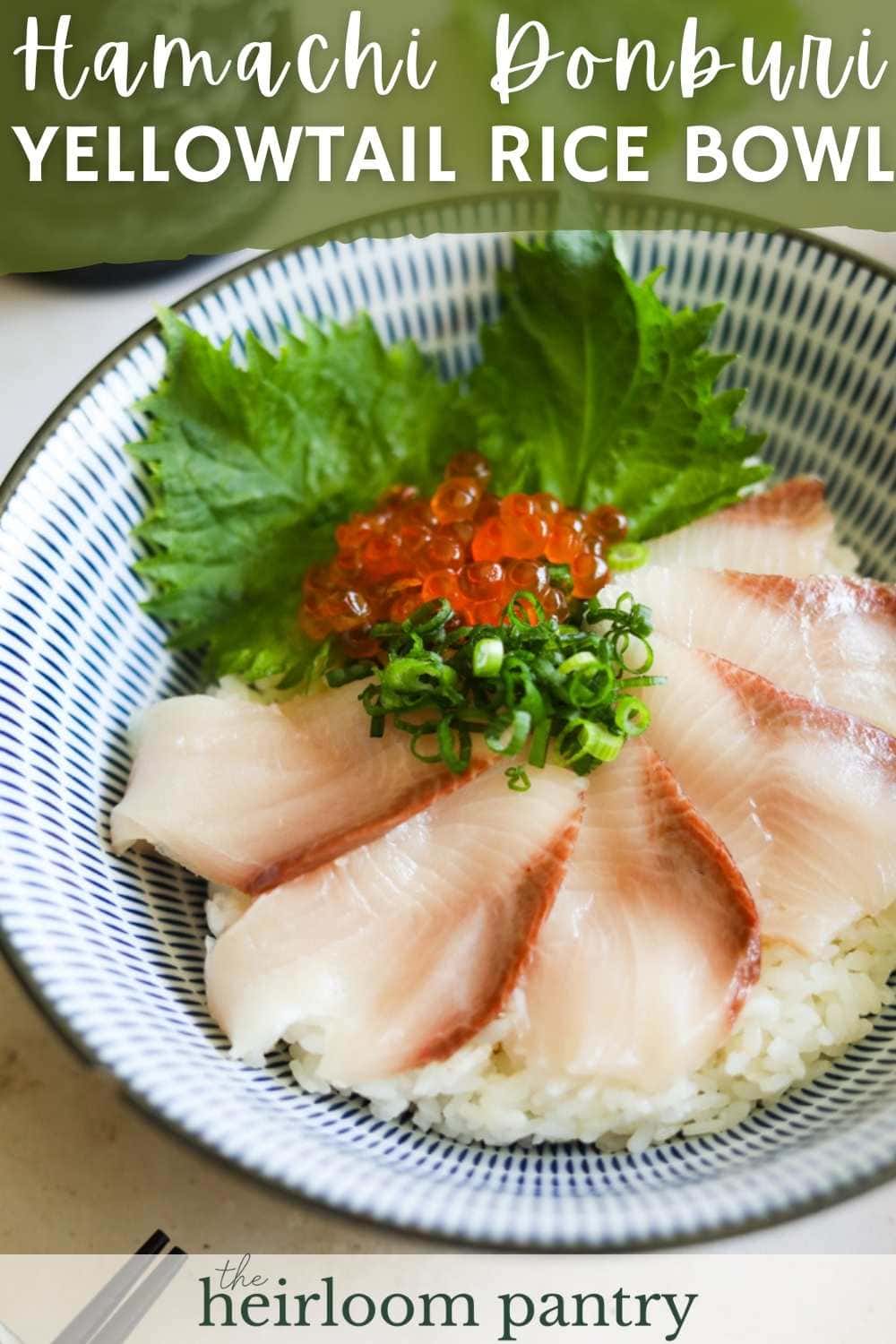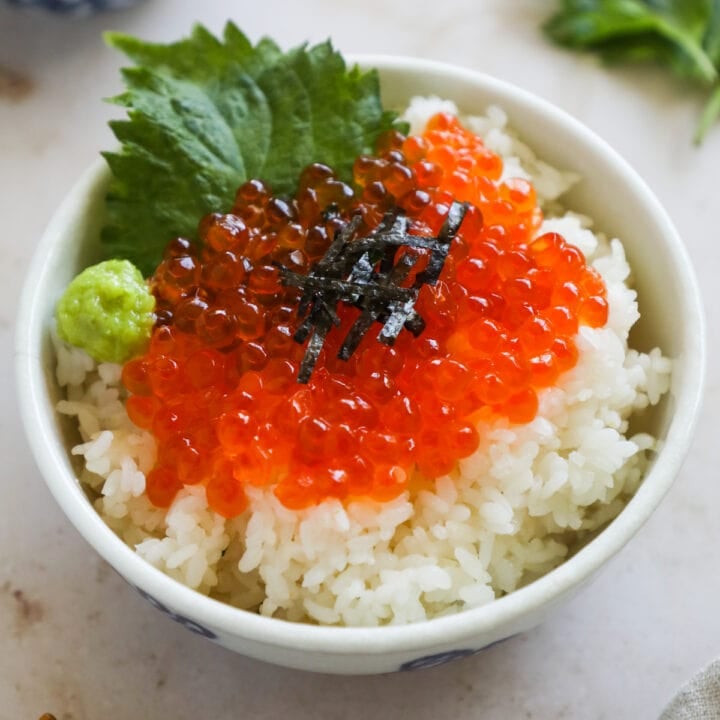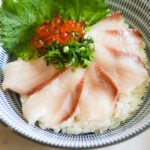Yellowtail Sashimi Bowl is a Japanese rice bowl featuring soft and buttery hamachi, rich ikura, and fragrant shiso leaves. This bowl takes just a few minutes to assemble and makes the perfect lunch or light dinner.

Hamachi donburis are one of our favorite ways to enjoy sashimi. The combination of ingredients is invigorating and it takes minimal effort to assemble. Given how lightly flavored the hamachi is, we enjoy this bowl with simple shoyu and wasabi for an extra kick.
Jump to:
About this Yellowtail Sashimi Donburi
- Taste - The mild flavored hamachi with the briny ikura and fragrant shiso leaves create a multi-dimensional bowl.
- Texture - The hamachi is smooth and buttery while the rice is firm. The ikura is soft with a slight bite.
- Effort - Other than precisely cutting the fish, you just need to make the rice then assemble the bowl.
- Time - It takes about a half hour to cook the rice then another 5 minutes to slice the sashimi and assemble the don.
What is a donburi?
Donburi translates to "bowl" in English. These Japanese rice bowls typically feature fish or meat over steamed Japanese rice. We enjoy our hamachi donburis with a side of shoyu, wasabi, and pickled ginger.
What is sashimi?
Sashimi is a simple and elegant dish featuring thinly sliced raw fish. The fish is typically served by itself (or with shoyu, or soy sauce) because the flavor of the fish is the main component. Dipping the fish in shoyu dipping sauce adds a rich umami flavor.
What is Hamachi?
Hamachi is also called Japanese amberjack or yellowtail (due its yellow striped side). Hamachi live in the Pacific ocean between Japan and Hawaii and are about 10 to 20 pounds when caught. When enjoyed as sashimi, its texture is soft and fatty with a mild flavor.
Ingredients

- Sushi-Grade Yellowtail fish - Fresh, sushi grade or sashimi grade yellowail sashimi is key to a delicious, safe hamachi bowl.
- Rice - Japanese short grain rice is best for donburis because it is lightly salted for flavor.
- Ikura - Ikura is a briny and mildly sweet addition.
- Shiso leaves - Shiso leaves add a fragrant and sweet accent to the bowl.
- Scallion - Scallion adds an aromatic flavor and a light crunch.
See recipe card for quantities.
Instructions

- Make rice - Rinse rice in a bowl until it runs clear. Then make rice on the stovetop or in an electric rice cooker pot. Remove from heat and fluff with a fork. Then transfer to rice to a bowl and season with seasoned rice vinegar. Fluff and fan the rice until slightly cooled.
- Thinly slice hamachi - Carefully slice yellowtail against the grain at a 45° angle. Be sure to pick how large you want the slices ahead of time and cut in one smooth motion. A standard thickness is about ⅜-inch thick.
- Assemble the bowl - Divide rice into two bowls. Place the thinly sliced hamachi, shiso leaf, ikura, and scallions on top of the hamachi. Serve with soy sauce and wasabi on the side.
Hint: Sashimi should be cut with a very sharp knife to ensure the pieces are pristine. Cut the fish across the grain and perpendicular to the spine to ensure the fragile proteins in the fish remain undamaged. Hold your knife steady and cut in one smooth motion to ensure the pieces are immaculate.
How to Enjoy this Yellowtail Sashimi Recipe
This donburi is best enjoyed by combining one piece of sashimi and some rice in a megabite. The combination of firm and neutral flavored rice with the fatty hamachi delicious. If you want to make a complete meal with this donburi, it pairs wonderfully with these other Japanese dishes:
- Spicy Kani Salad
- Unagi Sushi (Eel Hand Roll)
- Furikake and Lemon Shishito Peppers
- Ebi Tempura (Crispy Japanese Shrimp Tempura)
Substitutions
- Salmon Sashimi - Check out our salmon sashimi donburi if you prefer salmon to hamachi.
- Ikura - Make an ikura don if you like the texture and rich briny taste of ikura. Just keep in mind that ikura is expensive.
- Meat - Seasoned and sliced beef or chicken will also work well as a donburi.
Variations
- Soy sauce - Soy sauce, or shoyu, adds a deeply umami-rich component.
- Wasabi - Wasabi adds a refreshing and pungent spice.
- Pickled ginger - Add some pickled ginger for a mild ginger flavor that is refreshingly sweet and sour. Pickled ginger is particularly great if you plan on eating other sashimi or sushi with this dish because it will cleanse your palate between the different dishes.
- Tobiko or masago (Flying Fish Roe) - Replace ikura with tobiko or its cheaper cousin, masago, for a slightly sweeter roe.
- No rice - We often enjoy this dish with rice because it's neutral flavor pairs well with the sashimi. However, if you want the sashimi to really shine, eat it without the rice and just a little bit of shoyu.
- Eel sauce - Drizzle the donburi with some eel sauce (Unagi no tare) to add tangy sweetness to the sashimi. Eel sauce is a sake, mirin, sugar, and soy sauce reduction.
- Sushi rice - Add Seasoned rice vinegar to normal rice to make sushi rice. The vinegar adds a light sweet and tart flavor to the rice.
- Scallions - Scallions add an aromatic flavor and a little crunch.
- Furikake - Furikake is a Japanese seaweed seasoning commonly made of dried seaweed, sesame seeds, and salt. It adds an ocean-like flavor to this seafood dish.
- Yuzu Ponzo sauce - Enjoy yuzu ponzu sauce on the side for dipping. Yuzu ponzu sauce is a tangy and citrusy sauce that is slightly lighter than shoyu.
FAQ
The ingredients are usually available at Japanese markets, like Mitsuwa or Nijiya, or some common chain grocery stores. Sushi grade fish is also usually available in Japanese grocery stores, Whole Foods, or small specialty grocers. If they don't have it, you can also go to a local fish monger or seafood market. If you are based in the San Francisco Bay Area, we highly recommend Four Star Seafood, a chef-curated grocery service.
While hamachi is raw, it is safe to eat. Just make sure that you don't leave the raw yellowtail unrefrigerated for an extended period of time. Also, don't eat this dish if you are pregnant since there is a risk of harmful bacteria.
No, it's actually Japanese amberjack, a fish that lives in the Pacific ocean between Japan and Hawaii.
They are 2 different fish. Yellowfin is tuna while yellowtail is amberjack. While both are used in sushi, they look and taste completely different.
Dogs can eat yellowtail, but you should avoid giving your dog raw fish since it may contain harmful bacteria like salmonella and listeria.
Equipment
This Japanese yellowtail recipe requires a few kitchen essentials. To make hamachi sashimi, you will need a knife and a cutting board. For the rice you will need a pot or rice cooker to make the rice and a rice paddle to scoop the rice.
Storage
This yellowtail sashimi donburi is best enjoyed immediately or within 1 day of making. Store it in an air-tight container in the refrigerator. The key is to keep the moisture locked in so the rice doesn't dry out. This hamachi recipe does not stand up well to freezing.
Top Tips
- Cool the rice - Make sure the steamed rice is cool before adding the yellowtail sashimi. The temperature of the rice should match the temperature of the fish so the delicate fish doesn't cook.
- Fish medley - Add sushi grade salmon or spicy tuna for a yummy fish medley.
- Sauce on the side - Serve with soy sauce on the side instead of on top so the rice stays sticky and won't fall apart when you try to eat it.
- Use a large bowl - Serve this dish in a large bowl or donburi bowl (slightly smaller than ramen bowls) to ensure all of the ingredients will fit.
Related Recipes
Did You Like this Recipe?
Love this sashimi bowl recipe? Please leave a 5-star rating in the recipe card below and leave a comment below. Thanks!
Sign up for THP's newsletter and keep in touch on Instagram, Facebook, Pinterest, TikTok, and YouTube. If you make this recipe, tag #theheirloompantry so we can see your hamachi donburi!
📖 Recipe
Yellowtail Sashimi Bowl (Hamachi Donburi)
Equipment
Ingredients
- 1 cup rice
- 1⅓ cup filtered water
- ½ lb sashimi grade yellowtail (hamachi) sliced
- 2 tablespoon ikura
- 1 scallion finely sliced
- soy sauce (shoyu) for serving
- wasabi for serving
Instructions
Rice
- Stovetop instructions - Place rice in a saucepan and rinse the rice in the sink until the water runs clear, then drain. Combine washed rice and filtered water in a medium saucepan. Bring the rice to a low boil, then reduce the heat to low. Cover the pot and simmer for 20 minutes or until the water is absorbed. Remove from the heat and let sit covered for 10 minutes. Fluff the rice with a fork.1 cup rice, 1⅓ cup filtered water
- Rice cooker instructions - Place rice in the electric rice cooker pot and rinse the rice in the sink until the water runs clear, then drain. Combine rice and filtered water in the pot and cook per the rice cooker directions.1 cup rice, 1⅓ cup filtered water
- Cool rice - Season with seasoned rice vinegar if desired. Let the rice cool while you prep the other ingredients.
Hamachi Sashimi Donburi
- Thinly slice hamachi - Carefully slice yellowtail against the grain at a 45° angle. Be sure to pick how large you want the slices ahead of time and cut in one smooth motion. A standard thickness is about ⅜-inch thick.½ lb sashimi grade yellowtail (hamachi)
- Assemble the bowl - Divide rice into two bowls. Place the thinly sliced hamachi, shiso leaf, ikura, and scallions on top of the hamachi. Serve with soy sauce and wasabi on the side.½ lb sashimi grade yellowtail (hamachi), 2 tablespoon ikura, 1 scallion, soy sauce (shoyu), wasabi
Notes
Storage
This yellowtail donburi is best enjoyed immediately or within 1 day of making. Store it in an air-tight container in the refrigerator. The key is to keep the moisture locked in so the rice doesn't dry out. This hamachi recipe does not stand up well to freezing.Top Tips
- Cool the rice - Make sure the steamed rice is cool before adding the fish. The temperature of the rice should match the temperature of the fish so the delicate fish doesn't cook.
- Fish medley - Add hamachi or tuna for a yummy fish medley.
- Sauce on the side - Serve with soy sauce on the side instead of on top so the rice stays sticky and won't fall apart when you try to eat it.
- Use a bowl - Serve this dish in a large bowl or donburi bowl (slightly smaller than ramen bowls) to ensure all of the ingredients will fit.












Leave a Reply